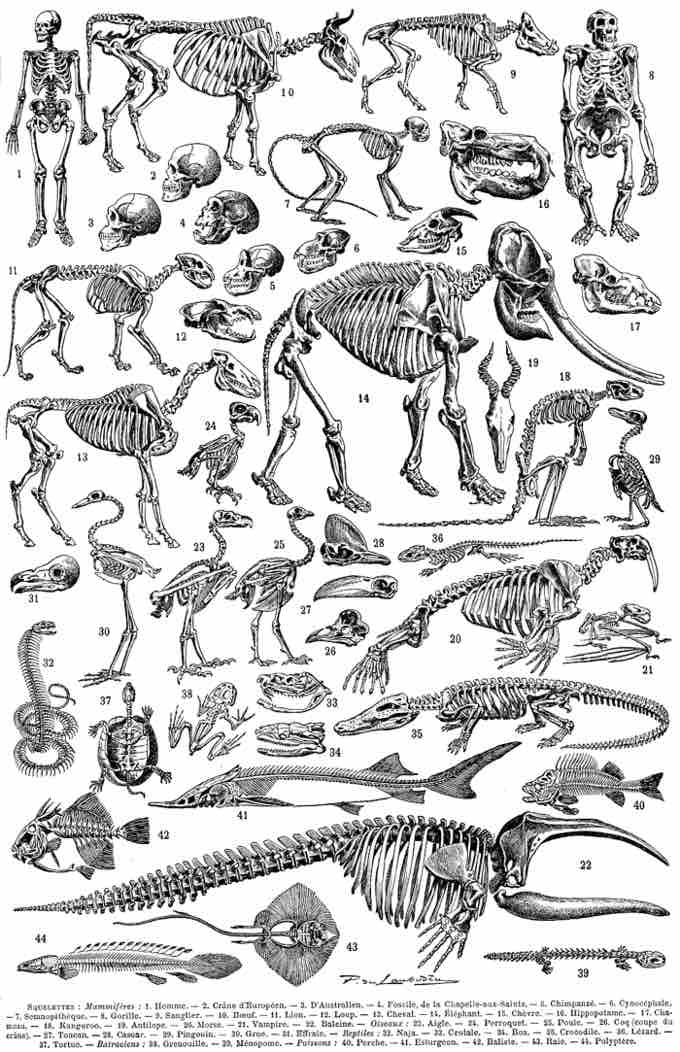Characteristics of Vertebrates
Vertebrates are members of the subphylum Vertebrata, under the phylum Chordata and under the kingdom Animalia . Animals that possess bilateral symmetry can be divided into two groups, protostomes and deuterostomes, based on their patterns of embryonic development. The deuterostomes, whose name translates as "second mouth," consist of two phyla: Chordata and Echinodermata. Echinoderms are invertebrate marine animals that have pentaradial symmetry and a spiny body covering; the phylum includes sea stars, sea urchins, and sea cucumbers. The phylum Chordata contains two groups of invertebrate chordates, but the most conspicuous and familiar members of Chordata are the vertebrates.
Phylum chordata
All chordates are deuterostomes, possessing a notochord. Vertebrates are differentiated by having a vertebral column.
As chordates, all vertebrates have a similar anatomy and morphology with the same qualifying characteristics: a notochord, a dorsal hollow nerve cord, pharyngeal slits, and a post-anal tail. However, the subphylum Vertebrata is distinguished from the phylum Chordata by the development of the notochord into a bony backbone. Vertebrates include the amphibians, reptiles, mammals, and birds, as well as the jawless fishes, bony fishes, sharks, and rays .

Diversity of vertebrates: animals with backbones
The subphylum Vertebrata contains all animals that possess backbones, gills, and a central nervous system in at least one phase of development. Vertebrates include amphibians, reptiles, mammals, and birds, as well as the jawless fishes, bony fishes, sharks, and rays.
More than 64,000 species of vertebrates have been described, but the extant vertebrate species represent only a small portion of all the vertebrates that have existed. Vertebrates range in size from the frog species Paedophryne amauensis (as small as 7.7 mm (0.3 inch)) to the blue whale (as large as 33 m (110 ft)). Vertebrates comprise about 4 percent of all described animal species; the remainder are invertebrates, which lack backbones.
Anatomy and Morphology
All vertebrates are built along the basic chordate body plan: a stiff rod running through the length of the animal (vertebral column), with a hollow tube of nervous tissue (the spinal cord) above it and the gastrointestinal tract below. In all vertebrates, there is a mouth at anterior end of the animal and an anus before the posterior end of the body. There is a tail posterior to the anus during at least one phase of the animal's development.
The Vertebral Column
Vertebrates are defined by the presence of the vertebral column. In vertebrates, the notochord develops into the vertebral column or spine: a series of bony vertebrae each separated by mobile discs . These vertebrae are always found on the dorsal side of the animal. However, a few vertebrates have secondarily lost their vertebrae and, instead, retain the notochord into adulthood (e.g., the sturgeon fish).
Vertebral column
A fossilized skeleton of the dinosaur Diplodocus carnegii shows an extreme example of the backbone that characterizes vertebrates.
Central Nervous System
Vertebrates are also the only members of Chordata to possess a brain. In chordates, the central nervous system is based on a hollow nerve tube that runs dorsal to the notochord along the length of the animal. In vertebrates, the anterior end of the nerve tube expands and differentiates into three brain vesicles.
Vertebrate Classification
Vertebrates are the largest group of chordates, with more than 62,000 living species. Vertebrates are grouped based on anatomical and physiological traits. The traditional groups include Agnatha, Chondrichthyes, Osteichthyes, Amphibia, Reptilia, Aves, and Mammalia.
Animals that possess jaws are known as gnathostomes, meaning "jawed mouth." Gnathostomes include fishes and tetrapods (amphibians, reptiles, birds, and mammals). Tetrapods can be further divided into two groups: amphibians and amniotes. Amniotes are animals whose eggs are adapted for terrestrial living; this group includes mammals, reptiles, and birds. Amniotic embryos, developing in either an externally-shelled egg or an egg carried by the female, are provided with a water-retaining environment and are protected by amniotic membranes.